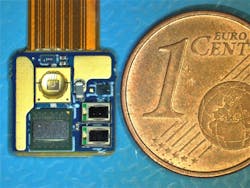Affirming its commitment to using laser diodes rather than LEDs as a means to deliver faster Li-Fi, France’s Oledcomm introduced a system that operates at 2 Gbps, doubling the company’s previous top speed of 1 Gbps.
Also with speed in mind, Oledcomm designed its new LiFiMAX2G using its customary infrared spectrum, which it believes supports faster optical transmission compared to typical phosphor-coated visible-light–emitting devices.
The infrared VCSEL laser diodes in the system come from ams Osram. The LiFiMAX2G uses two VCSELs per transceiver, which is how Oledcomm doubled the speed compared to the single VCSEL of the current generation, called the LiFiMAX1G.
Oledcomm, based outside of Paris in Vélizy-Villacoublay, no longer uses visible light in any of its offerings, as it has reshaped itself strictly as an optical communications company with no general illumination offerings.
The company is positioning the LiFiMAX2G for vehicle-to-infrastructure communication and for factory floor machinery, rather than for consumer laptop or tablet use. In the consumer market, where eye safety can be an issue at sites such as schools, the company will continue to develop LED-based Li-Fi offerings. Oledcomm’s dual laser and LED Li-Fi roadmap also places LEDs in situations that require lower system costs.
Oledcomm has priced the new LiFiMAX2G at €6000 per link, the company told LEDs Magazine (the LiFiMAX1G is priced at €3000). A link consists of two laser-based transceivers — one at either end of the transmission at up to 5m apart. For example, a train car might be equipped with one transceiver, while a rail traffic signal with the other.
A spokesperson told LEDs that a railway company is trialing the LiFiMAX2G in Europe. The same customer has been using the 1-Gbps LiFiMAX1G, as has a Formula 3 race car team, she said. (Formula 3 is a professional car racing circuit with competitions at slower speeds than Formula 1 and Formula 2.)
Oledcomm introduced LiFiMAX2G last week at the CES consumer electronics show in Las Vegas, although the intended market is not specifically consumer oriented.
“LiFIMAX2G is particularly suited for subways, trains, and any vehicle that needs to download huge amounts of data in terabytes (images and videos) in less than 20 seconds as well as for industrial Industry 4.0 applications in augmented reality, IoT or M2M (machine to machine),” the company stated.
The CES introduction makes good on the company’s recent pledge to advance its laser-based offerings for use in short-distance, M2M settings and other environments.
“The dizzying growth in the amount of data collected in mobility situations and the increase in multimedia flows require a reliable and uninterrupted communication standard for all, especially in transport and factory 4.0,” Oledcomm co-CEO Benjamin Azoulay noted during last week’s product introduction.
Oledcomm is planning general availability of the 2-Gbps transceiver in June. Azoulay told LEDs that the company can build both the 1-Gbps and 2-Gbps versions using 850-nm and 940-nm chips, but that a set of transceivers must have the same of one of those two frequencies.
MARK HALPER is a contributing editor for LEDs Magazine, and an energy, technology, and business journalist ([email protected]).
For up-to-the-minute LED and SSL updates, follow us on Twitter. You’ll find curated content and commentary, as well as information on industry events, webcasts, and surveys on our LinkedIn page and our Facebook page.






